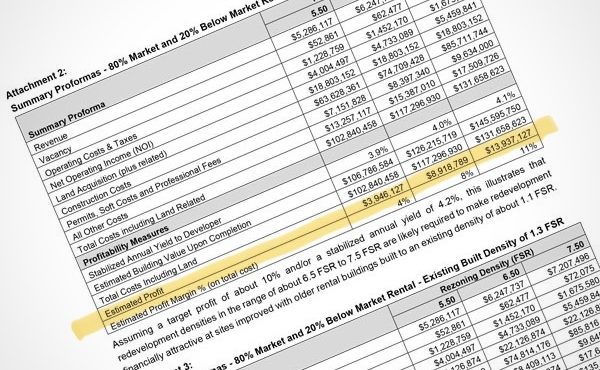Vancouver’s Worst Zoning – 4743 Belmont Avenue, Vancouver (recently sold for $42 million). Image Credit: boomerinvancouver.com
$42 Million? Really? WTF?
How Did We Get Here? Are we on the Road To Nowhere? This Must NOT Be The Place. Are we really Nothing But Towers, Crosseyed and Painless, and what about those Slippery People? (Talking Heads references 1 – 6)
This week’s companion graphic novella “You Forgot About Me” (not all that comical) portrayed Vancouver’s version of “The Evict-us Games” with two fictional local folks sharing their housing woes. Vancouver is easily the eviction capital of Canada at 10.5% compared to 5.8% in Toronto and 4.2% in Montreal.
The novella is a primer on how Vancouver has historically regulated a for-profit—now over-heated—housing market. I believe the regulatory model, we have relied on for decades, no longer serves us. It is leaving many behind and compelling housing advocates to offer tours of “Vancouver’s Worst Zoning”—an act that symbolizes the lack of inclusionary, socially-responsible approaches to solving our housing crises.
Our current “market”— promoted by self-serving supply-side zealots, and shaped by antiquated development rules—has unleashed a monster in the form of escalating, compounding land costs with development proponents holding the city’s commendable intentions ransom. The monster is cutting large swaths in the fabric of our city, leaving a lack of social diversity in its wake as it lumbers through our neighbourhoods. Mom and Pop are also running away from the monster, looking back and wondering if their small, locally-serving shops will also be trampled.
I lived the current discretionary zoning paradigm for 20 years as Vancouver’s Senior Urban Designer and Development Planner. I know how to deliver development projects, and what neighborhoods need to thrive. And I know many who are struggling to find decent housing and make a future in Vancouver. So I lose sleep. We are blowing it. I want to contribute by reflecting on how we got here, and by sharing fresh ideas for consideration. I also know through experience that getting folks together to talk about their shared future can illuminate new ways to support each other. I have found that an “aspirational process of urban design” always does this.
So the process of urban design can help us solve shared challenges. One of the many roles of urban design, in supporting city-making processes, is to creatively identify “multiple word score wins” (Scrabble reference) that are economically viable, and make the city a better place for all. I believe that thoughtful, creative placemaking conversations that include all stakeholders, and are informed by local insight, can reveal tailored development strategies that can be realized through more attentive zoning and discretionary consideration.
“Regulatory elegance” is possible through aspirational design conversations that explore how the market can deliver social benefit while remaining economically viable. A political system that is underpinned by urban design best practices will sustain itself by liberating market value in a disciplined way. I believe that a system that turns it back on urban design will ultimately fail with uncontrolled land escalation, ultimately leading to social instability. Urban design thinking will show us the way to resilience.
This 5-part series, released daily next week by Spacing Vancouver—bookended with this introduction and the final part of “You Forgot About Me” the following Monday—will reflect on Vancouver’s planning culture and zoning history (Part 1), as well as how and when we shifted away from our values and ways of serving everybody’s interest (Part 2). This will be followed by an overview of the stakeholders who have something to gain by working proactively together (Part 3) and an overview of 6 new, more socially responsible, housing zones that will aggressively address affordability (Part 4). The series will conclude with reflections on an applicable case study—False Creek South—that will remind us of how thoughtful urban design can support community life, including the delivery of more affordable housing made possible by creating new economic value. Finally, the last installment of You Forgot About Me will serve to wrap up the overall discussion.
Building from “You Forgot About Me,” the pieces are intentionally informal—sprinkled with humour, more musical references, and wordplay over and above attempting to avoid confusing jargon. Cities must be inclusive and this extends to the language we use to discuss them: language that everybody can understand.
The five-part series is also intended to be read in sequence, as a sum of the parts, with the ultimate goal of helping all stakeholders recognize that their self-interests are better served through shared solutions. While there is hard work ahead— and it will take special leadership at city hall—I believe that “getting to yes” can reveal new regulatory approaches that are much more effective at achieving affordability goals, especially towards non-market housing, than our current path.
We’ll start with Part 1 this upcoming Monday!
***
Related articles, in sequence:
- You Forgot About Me! – Part 1
- You Forgot About Me! – Part 2
- Zoning Must Evolve – Introduction
- Zoning Must Evolve – Part 1
- Zoning Must Evolve – Part 2
- Zoning Must Evolve – Part 3
- Zoning Must Evolve – Part 4
- Zoning Must Evolve – Part 5
- You Forgot About Me! – Part 3
**
Scot Hein is a retired architect, former senior urban designer at the City of Vancouver and the University of British Columbia. He is an adjunct professor of Urban Design at UBC, lecturer at Simon Fraser University and founding board member of the Urbanarium.




